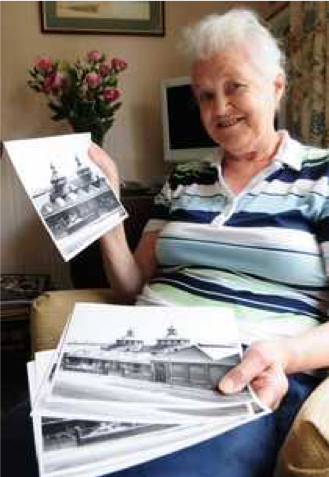Dr June Hargreaves: Planning Officer, conservationist and history enthusiast
It was a love of history that prompted June Hargreaves to come to York in 1961 as a Senior Planning Officer. Later, she became Assistant City Planning Officer, responsible for Development Control and Conservation. Born in 1937 she grew up in Cowling, West Yorkshire and, after attending Keighley Girls’ Grammar School, she started to train as a planning officer for West Riding County Council in Skipton, after which she gained her qualification as a Chartered Town Planner. Her training involved travelling to Leeds to study part time for five years and getting home by public transport late at night. She decided that she still needed more training on ‘Planning Law’, and so she studied for a further year. June attributes much of her success in her career to having worked with supportive colleagues and being in the right place at the right time. It would seem, however, that hard work also played a part.
When Anne Ellison interviewed her for a York Civic Trust oral history project, June told her friend that ‘A town is a place in which to live and work, and all planning solutions are inadequate if the town is solely to solve its traffic problem’.
Before 1967 it was possible to demolish a non-listed building without consent of the local authority. June believed that most buildings in a city like York were part of the townscape,whether or not they were listed, and that to demolish or alter one could detract from the aesthetic of the whole area. In her own time and armed with knowledge of York, she visited other historical towns and cities in order to write Historic Buildings: Problems Of Their Preservation. This book, published in 1964, caught the attention of the government of the day and introduced the concept of conservation areas; an idea which was subsequently incorporated into the 1967 Civic Amenities Act. A conservation area is defined as ‘an area of notable environmental or historic interest or importance which is protected by law against undesirable changes.’
Dr David Fraser, chief executive of the York Civic Trust, said in 2017 that: “It seems impossible to conceive of a time when the historic character of English street scene had no protection in law. June Hargreaves was the single most influential voice in England calling for the creation of Conservation Areas . . . At the time when women were not regarded as equal in the work place, she marshalled the arguments; expressed them eloquently in her seminal publication; and personally convinced senior civil servants and government ministers to change the law. June Hargreaves is a giant amongst conservationists”.
There are now in excess of 8,000 conservation areas in England; York was the first city to have designated conservation areas in 1968. (Stanford was the first town). There are now 35 conservation areas in York itself. As well as the central historic city centre, these include parts of Acomb, St Paul’s/Holgate Road, the Nestle/Rowntree factory and many more. In 1966 a relatively new system known as the York Town Scheme was set up in collaboration with central government; the aim was to grant-aid repairs to buildings in the historic centre; many of which were in a semi-derelict condition. The scheme was based on the city council and the government each contributing a quarter of the costs of repair and the individual property owners the balance. In the twenty-five years that it operated, over 650 buildings in the city were assisted by the scheme, which contributed substantially to the preservation of the City Centre.
In 1974, at the age of 37, June received an MBE for services to conservation.
She worked for the City Council until 1988, when she took early retirement on health grounds. Since then, she has followed her interests in York, the built environment, and history through being a founder/director of York Archaeological Trust, retiring in 2004 after 25 years, and as a member of York Civic Trust, retiring after 24 years.
Other committees June has or is still serving on include York Minster Advisory Committee; the Listed Buildings Advisory Committee for the Methodist Church nationally; Yorkshire Buildings Preservation Trust; the Historic Churches Committee for the Roman Catholic Church Diocese of Middlesbrough; The Noel Terry Charitable Trust; the Sheldon Memorial Trust; a founder member of Friends of Holy Trinity Church Goodramgate; the first woman of the Company of Merchant Taylors; and a Member of the Court of the University of York.
In addition to her MBE, June was presented with the first ever Lord Mayor’s Award in 2017 in honourof her contribution to preserving our great city. She received an Honorary Master’s Degree in 1987, and later a Doctorate from the University of York in 2000 at the Millennium Ceremony.
Sources:
The Press, York, 4 September 2017, ‘Meet June Hargreaves – The Woman Who Helped Save Historic York’ by Stephen Lewis;
Information supplied by Dr June Hargreaves, and conversations between Dr Hargreaves and Lynn Liddle.
Image of June Hargreaves ©The Press, York

